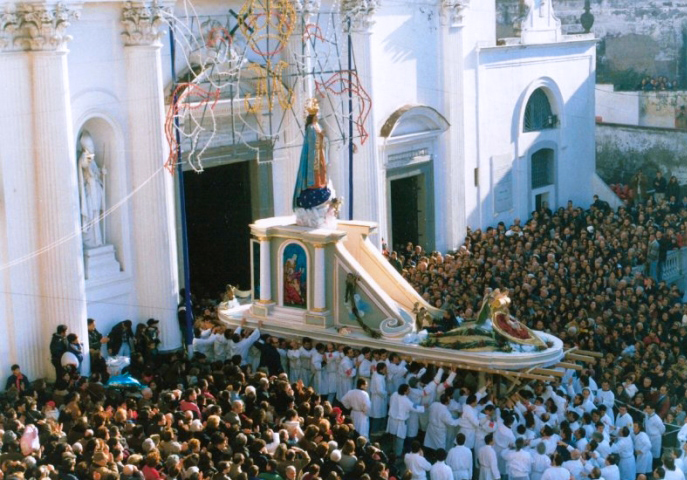La Colonna della Immacolata, or the Column of the Immaculate Conception, is a monument in central Rome that dates back to the 19th century. It depicts the Blessed Virgin Mary and is located in the Piazza Mignanelli. The Corinthian column itself was sculpted in ancient Rome and was re-discovered in 1777, during the construction of the Monastery of Santa Maria della Concezione in Rome. Since December 1953, Pontiffs have visited the monument on the feast of the Immaculate Conception and offered a bouquet of flowers. One of the traditions of the day includes the Pope kneeling in prayer and laying a floral wreath on the foot of the statue of the Madonna at the Piazza Mignanelli. The Chief of the Italian fire department also presents a bouquet with the motto “Flammas domamus, donamus Corda” (We stop fires, giving our hearts) while a fire truck is used to place a bouquet around the right arm of the Virgin Mary statue and another bouquet decorated with SPQR label is placed on the bottom of the statue. This signals the official beginning of the Christmas season in Rome and all of Italy.
The Immaculate Conception is one of the most important holidays to Roman Catholics and Italians. It is a holiday that encourages bonding between friends and family members and is marked with beautiful and elaborate processions throughout Italy. Unlike in the U.S. where even Good Friday is under assault by groups that wish to change its status, in Italy, December 8th is a public holiday. Many people who are off from work attend mass, then put up their Christmas trees and other holiday decorations.
In Ciminna in Sicily, there is a procession that takes place on the Sunday following December 8, called U triunfu, or The Triumph. This tradition dates back to the late 1700s, when the friars of the Convent of San Francesco D’Assisi in Ciminna, commissioned the statue of the Immacolata to be delivered on December 7, in time for the celebrations of the next day. All the people of Ciminna, growing impatient with the delay and the delivery of the holy statue, took matters into their own hands. They picked it up and with fiery torches ablaze, carried it triumphantly through the streets of the town to the church, where it stands to this day. Each year, the people of Ciminna gather to carry the holy statue through the town carrying torches and playing music. In other towns such as Castellana Sicula in Sicily, the festivities for the Immacolata Conception coincide with the creation of the traditional presepio for Christmas season. At this time of the year, each household bakes a special bread called muffuletta that is eaten in devotion to the Immacolata.
In Maglie, located in the region pf Puglia, people honor the Virgin Mary by behaving solemnly and eating puccia. Puccia comes in many forms, but it always consists of bread, cheese, olives, olive oil and tomatoes. In the northern regions bonfires are a common sight during the evening and night of the holiday. According to traditional beliefs, these fires destroy sins, but it also allows people to congregate in open spaces during cold December nights. Informal bonfire competitions between nearby towns and villages also take place during the Immaculate Conception. These competitions result in Italians building large roaring fires that often make entire towns glow.
The Abruzzo and Molise regions are home to an even older tradition as zampognari, playing their bagpipes, come down from the hills and play their music in towns. The added bonus of heading to rural regions of central Italy is that you are likely to be sharing the holiday with Italians and will have the chance to experience the warmth and hospitality during the most wondrous time of the year. Let the season of joy begin!




